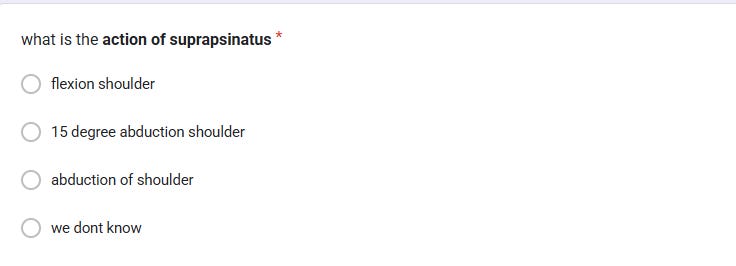supraspinatus
One of my favorite questions is: What is the action of the supraspinatus?
Most people would immediately answer, "15 degrees of abduction." That’s exactly what I learned in college.
Back in the early '90s, when I was in school, our college library was one of the best around. Since the institution had been established only a few years earlier, we had access to the latest editions of some truly outstanding books. At the time, books written by therapists were relatively scarce—at least in our library—and the scientific explanations were often poor. Anyone who has read Adult Hemiplegia by Berta Bobath can certainly attest to this.
One of the pioneers in rehabilitation and anatomy was John Basmajian. He served as the editor-in-chief for a series of books on rehabilitation, which formed a significant part of what I studied in college and during my first ten years of work.
I had read several of his books, but it wasn’t until I started my first job that I stumbled upon Muscles Alive. At the time, I was teaching biomechanics and was eager to explore what Basmajian had written.
Fascination with muscles and their function has existed for centuries. However, the discovery of galvanic current—and the realization that the neuromuscular system operates on electrical signals—was a game-changer for anatomy and neurophysiology.
Using faradic stimulation on individual muscles, Duchenne documented their actions in his book Physiology of Motion, describing muscle function by directly stimulating living muscles.
After the 1950s, advancements in electromyography (EMG) enabled scientists to study the neuromuscular system in a more dynamic way. Muscle activity was now analyzed in real-time during movement, offering deeper insights into its function. Researchers began examining muscle activation in various conditions, including standing, perturbation, and walking.
Muscles Alive: Their Functions Revealed by Electromyography John V. Basmajian- what did i learn from the book
When I was in college, I simply assumed certain muscles were active in different positions. But Basmajian introduced me to a different approach—not to assume, but to actually observe muscle activity via EMG. His book revealed what truly happens during standing versus relax standing (by commanding the subjects to relax the shoulders). For the first time, I learned to appreciate the subtle differences between the two. When the command of "relaxation" given many subjects relaxed muscles like the trapezius with EMG activity dropping to a flat line. Yet, what fascinated me most was discovering that even in relaxed standing, the supraspinatus doesn’t fully relax—it remains active.
What does it mean?
Welll it means it is a truly a antigravity muscle, along with muscles like soleus and neck muscles. I was truly happy to read them and have a better understanding.
More about supraspinatus:
Numerous EMG studies have been conducted to analyze the movement of abduction. Since the supraspinatus is positioned almost horizontally at a right angle to the humerus, it was traditionally assumed to be active only during the initiation of abduction. However, research from the 1960s revealed that the supraspinatus remains active throughout the entire range from 0 to 90 degrees of abduction.
Newer textbooks on anatomy and biomechanics acknowledge that the supraspinatus remains active throughout the entire range of abduction. However, the widely referenced textbook Chaurasia still states that it functions only up to 15 degrees—almost as if the "microprocessor" in the shoulder detects this point and shuts the muscle off.
As a result, many continue to assume that the supraspinatus is merely an initiator of abduction rather than an essential muscle throughout the movement. As I’ve already noted, the supraspinatus is a true anti-gravity muscle, remaining active even when the arm hangs at the side. This makes it a crucial muscle in preventing shoulder subluxation in acute stroke patients who lack muscle activity. John Basmajian made a model for how this happens and how it is prevented by suprapinatus in the book and in this article
So thats the answer for 2 questions i asked in the earlier quiz i posted.
PS. Of course now we know how the supraspinatus along with other muscles help in keeping the shoulder joint stable. The deltoid may also help as showed by some studies, Thats why i added the most important to make it intresting.
Want to take the quiz? You can participate anonymously!
click here
https://docs.google.com/forms/d/e/1FAIpQLSeF-y0N8vNCgU5IkEPdBCtFVGWWMRsBbak5dMlGRKaQL4DXBA/viewform
love
Hariohm







